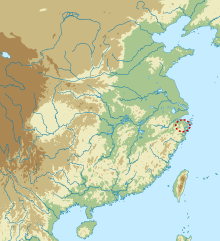Hemudu
 |
|||||||
| Geographical range | Eastern China | ||||||
|---|---|---|---|---|---|---|---|
| Period | Neolithic China | ||||||
| Dates | c. 5500 – c. 3300 BC | ||||||
| Preceded by | Kuahuqiao culture | ||||||
| Followed by | Liangzhu culture | ||||||
| Chinese name | |||||||
| Chinese | 河姆渡文化 | ||||||
|
|||||||
| Transcriptions | |
|---|---|
| Standard Mandarin | |
| Hanyu Pinyin | Hémǔdù wénhuà |
The Hemudu culture (5500 BC to 3300 BC) was a Neolithic culture that flourished just south of the Hangzhou Bay in Jiangnan in modern Yuyao, Zhejiang, China. The culture may be divided into an early and late phases, before and after 4000 BC respectively. The site at Hemudu, 22 km north-west of Ningbo, was discovered in 1973. Hemudu sites were also discovered on the islands of Zhoushan. Hemudu are said to have differed physically from inhabitants of the Yellow River sites to the north. Scholars view the Hemudu Culture as a source of the proto-Austronesian cultures.
Some scholars assert that the Hemudu culture co-existed with the Majiabang culture as two separate and distinct cultures, with cultural transmissions between the two. Other scholars group Hemudu in with Majiabang subtraditions. Two major floods caused the nearby Yaojiang River to change its course and inundated the soil with salt, forcing the people of Hemudu to abandon its settlements. The Hemudu people lived in long, stilt houses. Communal longhouses were also common in Hemudu sites, much like the ones found in modern-day Borneo.
The Hemudu culture was one of the earliest cultures to cultivate rice. Recent excavations at the Hemudu period site of Tianluoshan has demonstrated rice was undergoing evolutionary changes recognized as domestication. Most of the artifacts discovered at Hemudu consist of animal bones, exemplified by hoes made of shoulder bones used for cultivating rice.
The culture also produced lacquer wood. A red lacquer wood bowl at the Zhejiang Museum is dated to: 4000~5000 BC. It is believed to be the earliest such object in the world.
The remains of various plants, including water caltrop, Nelumbo nucifera, acorns, melon, wild kiwifruit, blackberries, peach, the foxnut or Gorgon euryale and bottle gourd, were found at Hemudu and Tianluoshan. The Hemudu people likely domesticated pigs, and dogs but practiced extensive hunting of deer and some wild water buffalo. Fishing was also carried out on a large scale, with a particular focus on crucian carp. The practices of fishing and hunting are evidenced by the remains of bone harpoons and bows and arrowheads. Music instruments, such as bone whistles and wooden drums, were also found at Hemudu. Artifact design by Hemudu inhabitants bears many resemblances to those of Insular Southeast Asia.
...
Wikipedia
